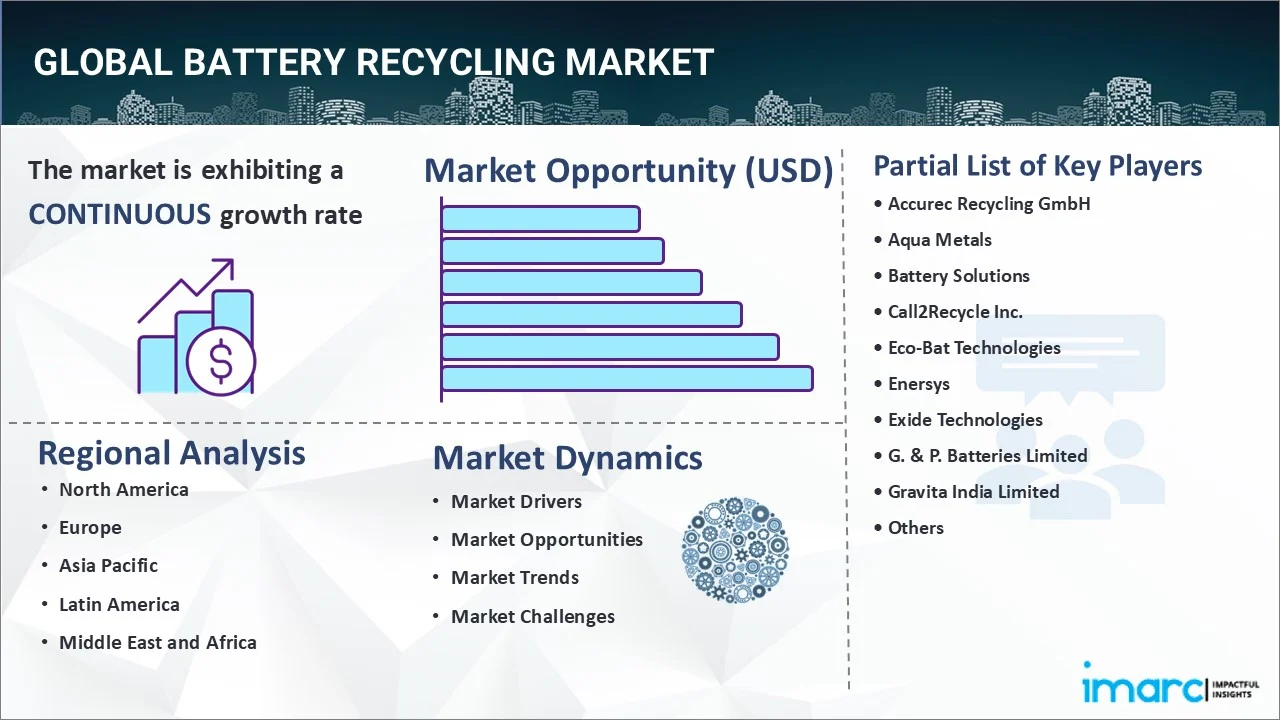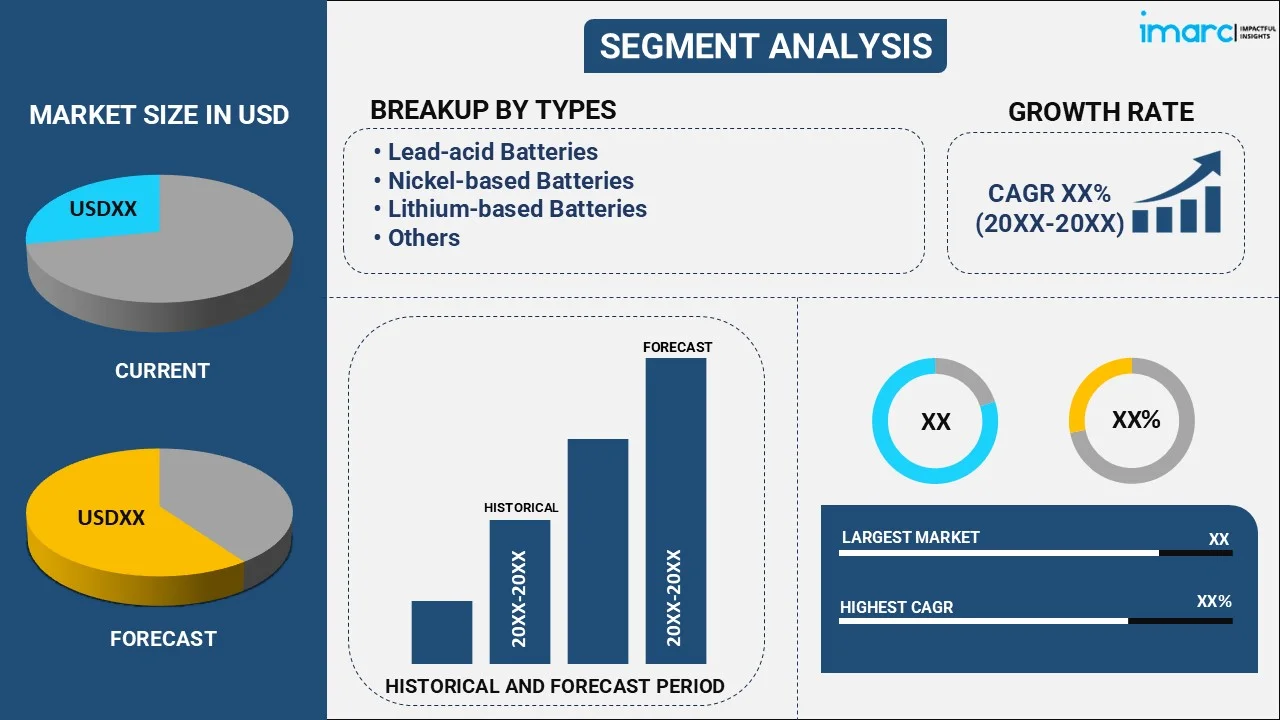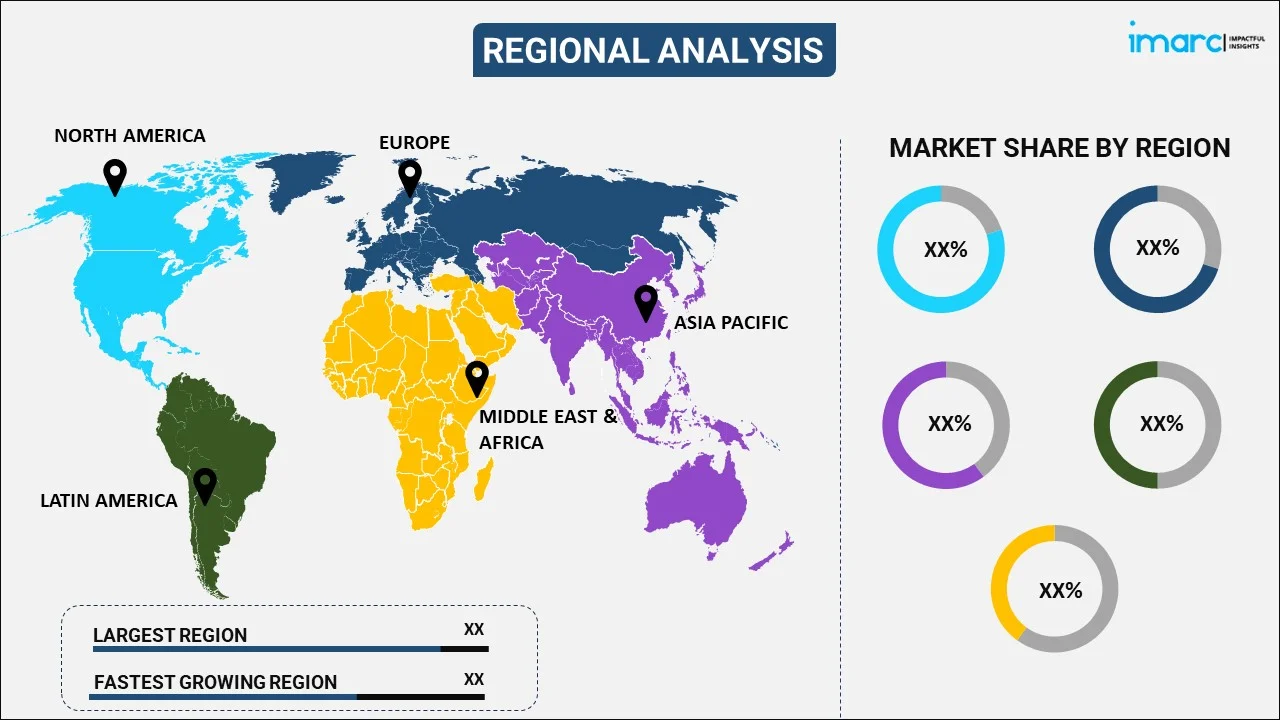
Battery Recycling Market Report by Type (Lead-acid Batteries, Nickel-based Batteries, Lithium-based Batteries, and Others), Source (Industrial, Automotive, Consumer Products, Electronic Appliances, and Others), End-Use (Reuse, Repackaging, Extraction, and Others), Material (Manganese, Iron, Lithium, Nickel, Cobalt, Lead, Aluminium, and Others), and Region 2025-2033
Battery Recycling Market Size, Share and Outlook 2025-2033:
The global battery recycling market size reached USD 16.8 Billion in 2024. Looking forward, IMARC Group expects the market to reach USD 32.7 Billion by 2033, exhibiting a growth rate (CAGR) of 6.88% during 2025-2033. Europe dominates the market, holding the largest battery recycling market share.
|
Report Attribute
|
Key Statistics
|
|---|---|
|
Base Year
|
2024 |
|
Forecast Years
|
2025-2033
|
|
Historical Years
|
2019-2024
|
| Market Size in 2024 | USD 16.8 Billion |
| Market Forecast in 2033 | USD 32.7 Billion |
| Market Growth Rate (2025-2033) | 6.88% |
Battery Recycling Market Analysis:
- Market Outlook: The battery recycling market is projected to grow significantly, driven by the rapid adoption of electric vehicles (EVs), rising demand for consumer electronics, and stricter environmental regulations. As governments and companies prioritize sustainable practices, there is an increased focus on recycling batteries to recover valuable metals like lithium, cobalt, and nickel, which helps reduce reliance on mining.
- Major Market Drivers: A major market driver is the implementation of environmental policies and regulations that encourage the practice of recycling, thereby improving technological innovations in various sectors for battery recycling. The increasing demand for electric vehicles is also fueling the battery recycling market growth due to the growing demand for efficient solutions to recycle spent batteries and recover materials in accelerating quantities.
- Key Market Trends: A major trend involves developing advanced recycling technologies, majorly hydrometallurgical and pyrometallurgical processes for efficiency improvement and cost reduction. Another developing trend is a rising interest in the concept of the circular economy and using recovered materials in the production of new batteries.
- Geographical Trends: According to the battery recycling market research report, the European market is experiencing significant growth due to stringent environmental regulations and robust recycling policies. Notably, the EU Battery Directive is a key driver, making Europe the largest regional market in this sector. On the other hand, North America is growing at a fast rate, driven by state-level regulations and increased adoption of electric vehicles.
- Competitive Landscape: Major key players are investing in innovative technologies of recycling so that material recovery rates improve. Some of the key players in the market include Accurec Recycling GmbH, Aqua Metals, Battery Solutions, Call2Recycle Inc., Eco-Bat Technologies, Enersys, Exide Technologies, G. & P. Batteries Limited, Gravita India Limited, Johnson Controls, Retriev Technologies Inc., and Umicore.
- Challenges and Opportunities: One major challenge in the market is the high cost of advanced recycling technologies and processes. On the other hand, numerous innovations and the growing investment in research and development (R&D) for low-cost, more efficient ways of recycling are creating lucrative opportunities in the market.

Battery Recycling Market Trends:
Environmental regulations and policies
The market is majorly influenced by the growing demand for sustainability and conservation of the environment. Various governments and regulatory bodies are enacting strict regulations aimed at minimizing hazardous waste and promoting the recycling of batteries. Under the existing policy framework, including the EU's Battery Directive and various U.S. state laws, proper disposal and recycling of hazardous batteries are required to reduce environmental and human exposure to potential health risks. These regulations motivate industries and consumers to increase acceptance of recycling, hence contributing to the battery recycling industry growth. Aside from this, international conventions controlling hazardous wastes in their cross-border movement further the mandate to recycle. This framework drives manufacturers to offer environmentally friendly recycling processes and technologies in line with the regulations set, thus driving innovation in the recycling sector. As such, environmental regulations are acting through the imposition of sustainable means and better technologies for recycling as major drivers of the market.
Growing demand for electric vehicles (EVs)
A major driver for the market is the increasing adoption of EVs among the masses. This can be supported by the rising demand for lithium-ion batteries powering the EVs. Recycling helps recover useful materials such as lithium, cobalt, and nickel from used batteries and puts them into the production of new ones. This decreases dependence on mining and raw material extraction. A model of this circular economy supports sustainability and is also one of the processes to solve the supply chain challenges connected with the supply of critical materials necessary for EV batteries. Additionally, EV manufacturers are investing in robust battery recycling infrastructure to meet environmental and regulatory goals that are favoring the market. Moreover, the rapid rise in demand for efficient battery recycling systems due to the growing EV sector is creating a positive battery recycling market outlook.
Technological advancements in recycling processes
Advancements in technologies for recycling are another major driver of the market. New chemical and mechanical innovations are providing easier and cheaper recycling, opening up further opportunities for recovering useful materials from spent batteries. For instance, the development of hydrometallurgy and pyrometallurgy processing technologies is enhancing the recovery rate of critical metals such as lithium, cobalt, and nickel utilized to fabricate new batteries. Along with this, mechanization in sorting and dismantling operations is making recycling operations easier and as labor force-intensive, with higher throughput rates achieved. Reduction of the impact on the environment by research and development in technologies for battery recycling also results in reducing energy consumption and safe processing of hazardous materials. These technological developments increase the economic value of battery recycling and enhance the quality of the raw materials recovered, shifting towards a more circular and effective recycling ecosystem. In addition to this, continuous technological innovation is one of the most influential factors promoting the battery recycling market growth.
Battery Recycling Market Segmentation:
IMARC Group provides an analysis of the key trends in each segment of the market report, along with forecasts at the global, regional and country levels for 2025-2033. Our report has categorized the market based on type, source, end-use, and material.
Breakup by Type:

- Lead-acid Batteries
- Nickel-based Batteries
- Lithium-based Batteries
- Others
Lead-acid batteries accounts for the majority of the market share
The report has provided a detailed breakup and analysis of the market based on the type. This includes lead-acid batteries, nickel-based batteries, lithium-based batteries, and others. According to the report, lead-acid batteries represented the largest segment.
The largest type in the market is represented by lead-acid batteries, due to their extensive application and well-established recycling processes. Major applications include automotive such as starting, lighting, and ignition batteries. Besides applications, they are utilized for backup power supply in telecommunication and other critical infrastructures. According to the battery recycling market insights, the recycling rate for these batteries runs high, mainly due to economic and environmental motivations. It is economically viable to recycle lead-acid batteries since a large quantity of lead can be recovered from them, and the market value is substantial. This process is also cost-effective since infrastructures for recycling are already available, and, compared to other options for battery disposal, it is relatively easy. Thus, diverse regulatory frameworks worldwide mandate the recycling of these batteries to prevent lead contamination. Furthermore, advancements in recycling technology are enhancing the recovery rate of lead while minimizing the environmental impact of the process. Consequently, higher battery recycling demand, coupled with economic feasibility, established infrastructure, and robust regulatory support, solidifies lead-acid batteries as the dominant segment in the market.
Breakup by Source:
- Industrial
- Automotive
- Consumer Products
- Electronic Appliances
- Others
Industrial holds the largest share of the industry
The report has provided a detailed breakup and analysis of the market based on the source. This includes industrial, automotive, consumer products, electronic appliances, and others. According to the report, industrial represented the largest segment.
The industrial segment accounted for the largest share of the source segment of the market due to the bulk volume of batteries being consumed by the industries in their respective applications. It caters to manufacturing industries, telecommunication industries, energy storage systems, and uninterruptible power supply units that require large-scale battery deployments to ensure operational efficiency and reliability. According to the battery recycling market dynamics, the rate of turnover of industrial batteries, especially lead-acid and lithium-ion types is becoming high due to the intensive usage and a comparatively shorter lifecycle is propelling the market. There is, therefore, an accumulation of huge spent batteries waiting in line for recycling. Their recycling is imperative for saving the environment and resource recovery since they contain critical materials, among them lead, nickel, cobalt, and lithium. In addition, regulatory requirements for proper disposal and recycling of industrial batteries to prevent environmental contamination and to provide safe handling of hazardous materials are driving the demand. Moreover, the value of recovered materials from industrial batteries itself provides impetus to the recycling industry by attracting investments in advanced technologies and infrastructure. Thus, the large volume contribution by the industrial segment and the critical need for sustainable disposal solutions ensure the dominance of this segment in the market.
Breakup by End-Use:
- Reuse
- Repackaging
- Extraction
- Others
The report has provided a detailed breakup and analysis of the market based on the end-use. This includes reuse, repackaging, extraction, and others.
Breakup by Material:
- Manganese
- Iron
- Lithium
- Nickel
- Cobalt
- Lead
- Aluminium
- Others
A detailed breakup and analysis of the market based on the material have also been provided in the report. This includes manganese, iron, lithium, nickel, cobalt, lead, aluminium, and others.
Breakup by Region:

- North America
- United States
- Canada
- Asia Pacific
- China
- Japan
- India
- South Korea
- Australia
- Indonesia
- Others
- Europe
- Germany
- France
- United Kingdom
- Italy
- Spain
- Russia
- Others
- Latin America
- Brazil
- Mexico
- Others
- Middle East and Africa
Europe leads the market, accounting for the largest battery recycling market share
The report has also provided a comprehensive analysis of all the major regional markets, which include North America (the United States and Canada); Asia Pacific (China, Japan, India, South Korea, Australia, Indonesia, and others); Europe (Germany, France, the United Kingdom, Italy, Spain, Russia, and others); Latin America (Brazil, Mexico, and others); and the Middle East and Africa. According to the report, Europe represents the largest regional market for battery recycling.
Europe is the largest geographical segment of the market, driven by strict environmental laws and regulations and solid policies for recycling. The European Union is adopting broad-ranging directives relating to the correct collection, treatment, and recycling of batteries to minimize their impact on the environment and also to ensure resource efficiency. These regulations enforce strict compliance from manufacturers and consumers, thereby significantly improving the recycling rates of batteries across the region. In addition, the commitment of Europe to sustainable development and circular economy policies is further fueling the market. Another driver of investment in recycling is the regional agenda to reduce dependence on raw material imports through the recovery of valuable materials including lithium, cobalt, and nickel from spent batteries. In addition, the increasing electric vehicle adoption in Europe is resulting in significant demand for battery recycling. Moreover, the battery recycling market outlook indicates that the implementation of various regulatory frameworks, technology advancements, and sustainability initiatives supports the European region to remain the largest as well as the most dynamic in the market.
Competitive Landscape:
The market research report has also provided a comprehensive analysis of the competitive landscape in the market. Detailed profiles of all major companies have also been provided. Some of the major market players in the battery recycling industry include:
- Accurec Recycling GmbH
- Aqua Metals
- Battery Solutions
- Call2Recycle Inc.
- Eco-Bat Technologies
- Enersys
- Exide Technologies
- G. & P. Batteries Limited
- Gravita India Limited
- Johnson Controls
- Retriev Technologies Inc.
- Umicore
(Please note that this is only a partial list of the key players, and the complete list is provided in the report.)
Key players in the market are investing in new, state-of-the-art recycling technologies and increasing operational capacity to meet the growing demand for sustainable ways of disposal of batteries. Companies such as Umicore, Johnson Controls, and Battery Solutions are developing their recycling techniques further by innovating hydrometallurgy and pyrometallurgy to achieve better source recovery rates with less environmental harm. Some strategic partnerships and collaborations help firms leverage combined expertise and resources to offer the best in their recycling operations and market reach. Furthermore, such companies are adhering to regulatory requirements and set sustainability goals by forcing environmentally friendly practices of international standards. Programs relating to raising consumer awareness and consumer participation in battery recycling programs further raise their market presence. The battery recycling market overview suggests that technology innovations, strategic collaborations, and strong commitments to environmental stewardship by key stakeholders are further driving the market forward.
Battery Recycling Market News:
- July 24, 2024: Novocycle Technologies announced significant advancements in its technology for battery recycling, enhancing a new industry standard in sustainability and efficiency. The cutting-edge process developed by Novocycle includes careful dismantling and disassembly of spent batteries, recovering the electrodes themselves for further processing. Some other unique features of Novocycle technology include the ability to recycle over 96% of a battery to unmatched levels of purity.
- January 18, 2023: Aqua Metals, Inc., a leader in clean lithium-ion battery recycling, announced the completion of due diligence on a property in Tahoe-Reno. It plans for the phased development of a five-acre recycling campus designed to process more than 20 million pounds of lithium-ion battery material annually with its Li AquaRefining technology.
Battery Recycling Market Report Scope:
| Report Features | Details |
|---|---|
| Base Year of the Analysis | 2024 |
| Historical Period | 2019-2024 |
| Forecast Period | 2025-2033 |
| Units | Billion USD |
| Scope of the Report | Exploration of Historical Trends and Market Outlook, Industry Catalysts and Challenges, Segment-Wise Historical and Future Market Assessment:
|
| Types Covered | Lead-acid Batteries, Nickel-based Batteries, Lithium-based Batteries, Others |
| Sources Covered | Industrial, Automotive, Consumer Products, Electronic Appliances, Others |
| End-Uses Covered | Reuse, Repackaging, Extraction, Others |
| Materials Covered | Manganese, Iron, Lithium, Nickel, Cobalt, Lead, Aluminium, Others |
| Regions Covered | Asia Pacific, Europe, North America, Latin America, Middle East and Africa |
| Countries Covered | United States, Canada, Germany, France, United Kingdom, Italy, Spain, Russia, China, Japan, India, South Korea, Australia, Indonesia, Brazil, Mexico |
| Companies Covered | Accurec Recycling GmbH, Aqua Metals, Battery Solutions, Call2Recycle Inc., Eco-Bat Technologies, Enersys, Exide Technologies, G. & P. Batteries Limited, Gravita India Limited, Johnson Controls, Retriev Technologies Inc., Umicore, etc. |
| Customization Scope | 10% Free Customization |
| Post-Sale Analyst Support | 10-12 Weeks |
| Delivery Format | PDF and Excel through Email (We can also provide the editable version of the report in PPT/Word format on special request) |
Key Benefits for Stakeholders:
- IMARC’s industry report offers a comprehensive quantitative analysis of various market segments, historical and current market trends, market forecasts, and dynamics of the battery recycling market from 2019-2033.
- The research report provides the latest information on the market drivers, challenges, and opportunities in the global battery recycling market.
- The study maps the leading, as well as the fastest-growing, regional markets. It further enables stakeholders to identify the key country-level markets within each region.
- Porter's five forces analysis assists stakeholders in assessing the impact of new entrants, competitive rivalry, supplier power, buyer power, and the threat of substitution. It helps stakeholders to analyze the level of competition within the battery recycling industry and its attractiveness.
- The competitive landscape allows stakeholders to understand their competitive environment and provides insight into the current positions of key players in the market.
Key Questions Answered in This Report
The global battery recycling market was valued at USD 16.8 Billion in 2024.
We expect the global battery recycling market to exhibit a CAGR of 6.88% during 2025-2033.
The rising demand for Electric Vehicles (EVs), along with the increasing adoption of recycled batteries in the manufacturing of various consumer electronics, is primarily driving the global battery recycling market.
The sudden outbreak of the COVID-19 pandemic had led to the implementation of stringent lockdown regulations across several nations, resulting in the temporary closure of numerous end-use industries for battery recycling.
Based on the type, the global battery recycling market has been segregated into lead-acid batteries, nickel-based batteries, lithium-based batteries, and others. Among these, lead-acid batteries currently hold the largest market share.
Based on the source, the global battery recycling market can be bifurcated into industrial, automotive, consumer products, electronic appliances, and others. Currently, industrial exhibits a clear dominance in the market.
On a regional level, the market has been classified into North America, Asia Pacific, Europe, Latin America, and Middle East and Africa, where Europe currently dominates the global market.
Some of the major players in the global battery recycling market include Accurec Recycling GmbH, Aqua Metals, Battery Solutions, Call2recycle Inc., Eco-Bat Technologies, Enersys, Exide Technologies, G. & P. Batteries Limited, Gravita India Limited, Johnson Controls, Retriev Technologies Inc., Umicore, etc.
Need more help?
- Speak to our experienced analysts for insights on the current market scenarios.
- Include additional segments and countries to customize the report as per your requirement.
- Gain an unparalleled competitive advantage in your domain by understanding how to utilize the report and positively impacting your operations and revenue.
- For further assistance, please connect with our analysts.
 Inquire Before Buying
Inquire Before Buying
 Speak to an Analyst
Speak to an Analyst
 Request Brochure
Request Brochure
 Request Customization
Request Customization




.webp)




.webp)












